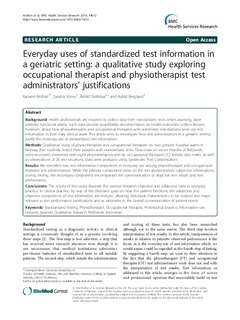| dc.contributor.author | Krohne, Kariann | |
| dc.contributor.author | Torres, Sandra | |
| dc.contributor.author | Slettebø, Åshild | |
| dc.contributor.author | Bergland, Astrid | |
| dc.date.accessioned | 2014-08-25T11:45:33Z | |
| dc.date.available | 2014-08-25T11:45:33Z | |
| dc.date.issued | 2014 | |
| dc.identifier.citation | Krohne, K., Torres, S., Slettebø, Å., & Bergland, A. (2014). Everyday uses of standardized test information in a geriatric setting : a qualitative study exploring occupational therapist and physiotherapist test administrators' justifications. BMC Health Services Research, 14, 1-10. doi: 10.1186/1472-6963-14-72 | nb_NO |
| dc.identifier.issn | 1472-6963 | |
| dc.identifier.uri | http://hdl.handle.net/11250/218002 | |
| dc.description | Published version of an article in the journal: BMC Health Services Research. Also available from the publisher at: http://dx.doi.org/10.1186/1472-6963-14-72 Open Access | nb_NO |
| dc.description.abstract | Background: Health professionals are required to collect data from standardized tests when assessing older patients' functional ability. Such data provide quantifiable documentation on health outcomes. Little is known, however, about how physiotherapists and occupational therapists who administer standardized tests use test information in their daily clinical work. This article aims to investigate how test administrators in a geriatric setting justify the everyday use of standardized test information. Methods. Qualitative study of physiotherapists and occupational therapists on two geriatric hospital wards in Norway that routinely tested their patients with standardized tests. Data draw on seven months of fieldwork, semi-structured interviews with eight physiotherapists and six occupational therapists (12 female, two male), as well as observations of 26 test situations. Data were analyzed using Systematic Text Condensation. Results: We identified two test information components in everyday use among physiotherapist and occupational therapist test administrators. While the primary component drew on the test administrators' subjective observations during testing, the secondary component encompassed the communication of objective test results and test performance. Conclusions: The results of this study illustrate the overlap between objective and subjective data in everyday practice. In clinical practice, by way of the clinicians' gaze on how the patient functions, the subjective and objective components of test information are merged, allowing individual characteristics to be noticed and made relevant as test performance justifications and as rationales in the overall communication of patient needs. | nb_NO |
| dc.language.iso | eng | nb_NO |
| dc.publisher | BioMed Central | nb_NO |
| dc.subject | VDP::Medisinske Fag: 700::Helsefag: 800 | nb_NO |
| dc.subject | fieldwork, geriatric patients, information use, interviews, occupational therapist, physiotherapist, professional practice, qualitative research, standardized testing | |
| dc.title | Everyday uses of standardized test information in a geriatric setting : a qualitative study exploring occupational therapist and physiotherapist test administrators' justifications | nb_NO |
| dc.type | Journal article | nb_NO |
| dc.type | Peer reviewed | nb_NO |
| dc.source.pagenumber | 1-10 | nb_NO |
| dc.source.journal | BMC Health Services Research | nb_NO |
| dc.identifier.doi | 10.1186/1472-6963-14-72 | |
